What is Chayote Squash and What Do I Do With It? Chayote (chai·ow·tei) squash, also known as mirliton squash or Mexican pear squash, is a small summer squash native to Mexico but now found worldwide in warmer climates.
Chayote, like the tomato, is technically a fruit although it is almost always prepared as a vegetable. This squash looks like a large, lumpy, unripe pear.
It has a color ranging from pale green to dark green with white flesh. Another favorite that we have discovered is cucamelons or Mexican Mouse Melons, which we grow each year at home. See some other unique vegetables like Jicama, Kohlrabi, Spaghetti Squash, and more.
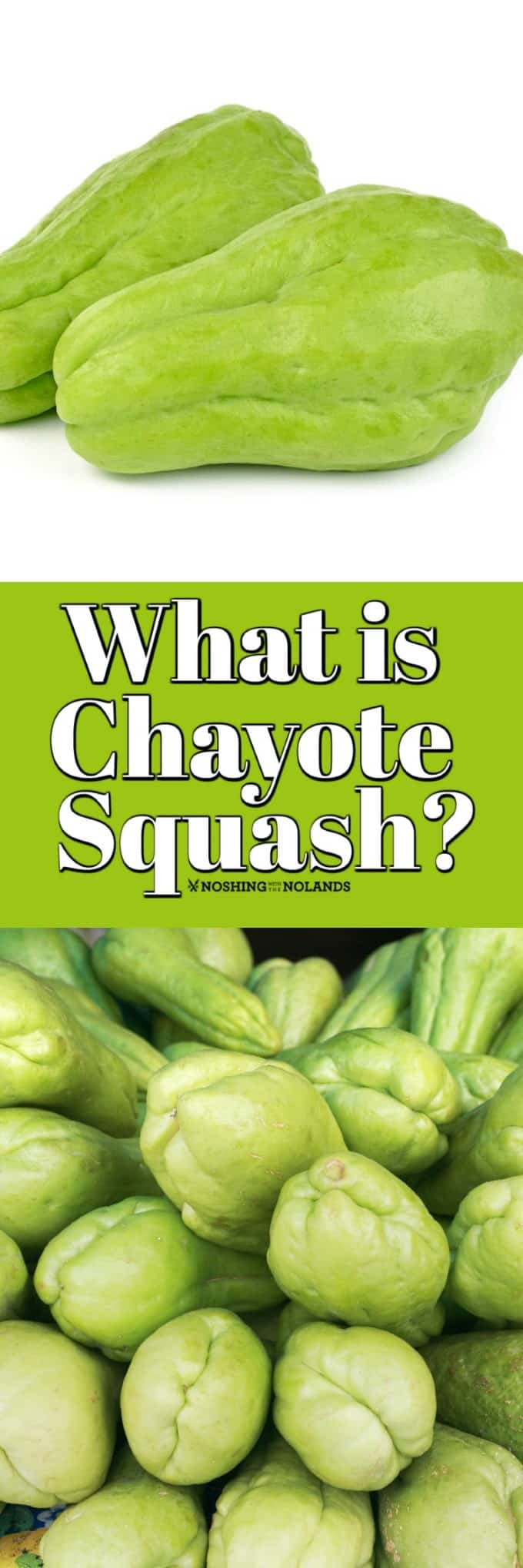
Some varieties have a spiny texture to the skin while others are smooth but bumpy. While chayote can be eaten raw or cooked, it is more commonly cooked unless being served in a salad or as an appetizer.
Raw chayote drizzled with lemon or lime juice and a pinch of salt is a favorite snack in many Southern households. The skin is edible and full of nutrients so leave it on when preparing chayote.
Check out our new How-To section to learn more about unusual produce plus great ideas for the kitchen and home.
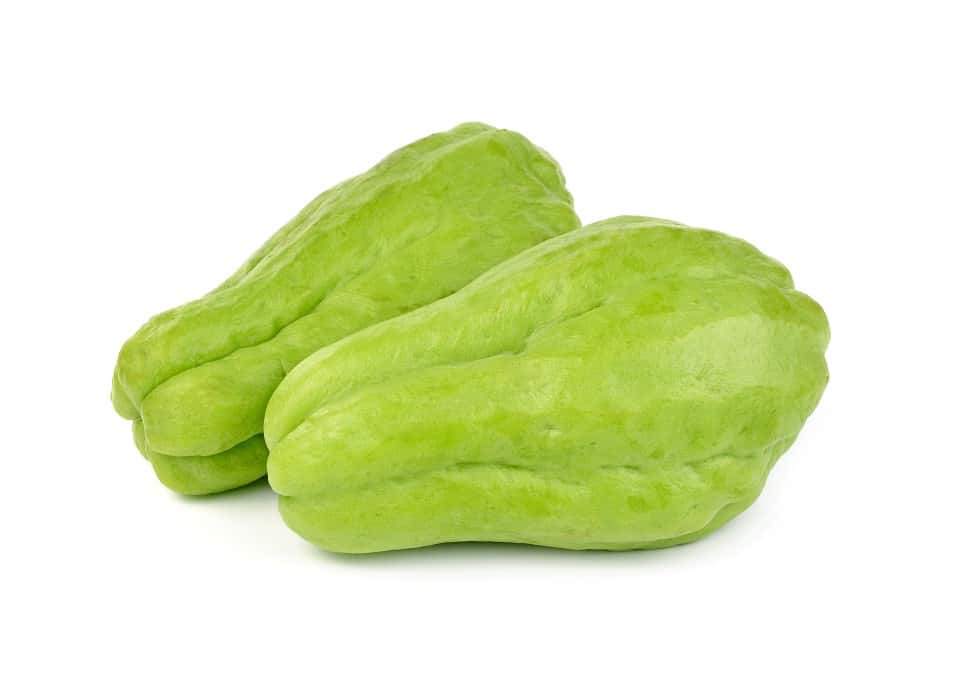
Helpful Items for This Post
This post contains affiliate links.
Benefits of Chayote Squash
Chayote is very healthy and is used as a replacement for starchy vegetables such as potatoes. A cup of chayote has 25 calories and only 6 grams of carbs so chayote is very popular with people who are doing Keto or other low-carb diets.
It is a good source of vitamin C, vitamin B, potassium, and amino acids. Chayote has been used in traditional medicine in Latin America and Asia for its anti-inflammatory properties and chayote tea is a common natural treatment for a variety of ailments.
What Does Chayote Squash Taste Like?
If you have ever tried Jicama they are a bit similar as Chayote is slightly sweet but also very, very juicy and crunchy like Jicama. Unlike Jicama’s colouring though Chayote is green on the outside to white or pale green on the inside.
The first time I tried them I thought it was honeydew on my plate but when tasted they burst with juice and were served hot with salt, pepper, and butter.
How to Cook Chayote Squash
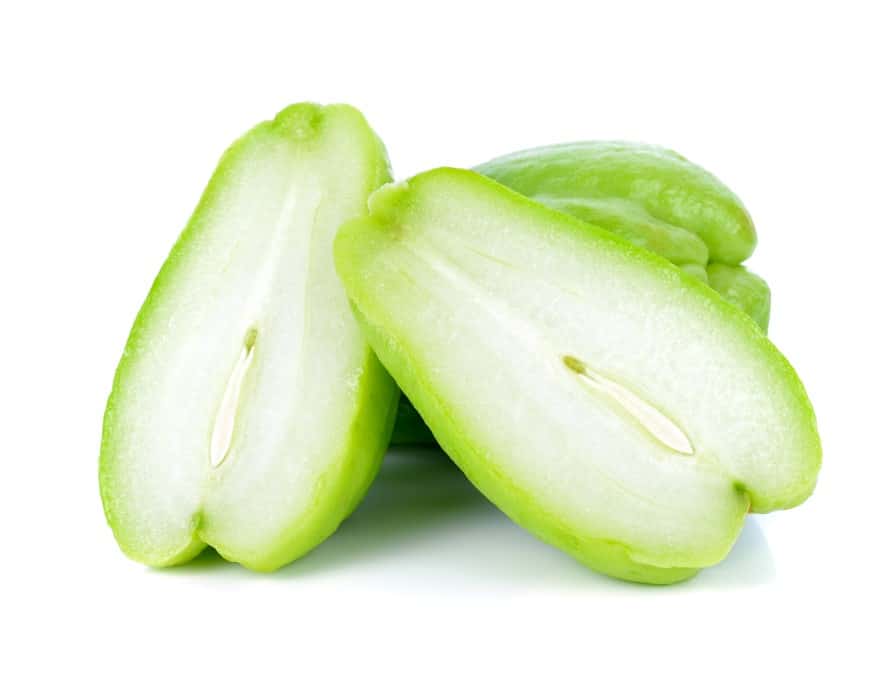
There are a number of ways to cook chayote squash. All parts of the plant can be used depending on how it is prepared.
In Southeast Asian cuisine, the young shoots of the chayote plant are used in a stir fry while the leaves and the fruit itself are used in soups.
Chayote can be used as a substitute for or in combination with other summer squash and roasted. Because it is water-rich, you should not add salt until after it is done cooking or it can become dehydrated.
Instead, simply chop the chayote fruit into small pieces and toss with about 2 tablespoons of oil – olive oil is a great one to use. Roast for 15-20 minutes at 375 degrees Fahrenheit.
You can use the roasted chayote as a side dish on its own or add it to a casserole or curry.
You can also grill chayote fruit by slicing it into medium slices (about the same thickness as you would zucchini or eggplant), brushing with olive oil, and grilling for 4-5 minutes per side.
One of the most popular uses of chayote squash is in soups. Because of its mild taste, the chayote squash is well suited to be used in soups. It does well with bold flavors and ingredients such as chipotle and hot peppers as it helps balance them out.
Also, another note is that when preparing chayote it tends to leave a white film on your hands that dries and feels restrictive and tight. For me, it has just washed off. This is from the sap of the fruit. If you want to avoid this then use gloves while preparing.
Where do I Buy?
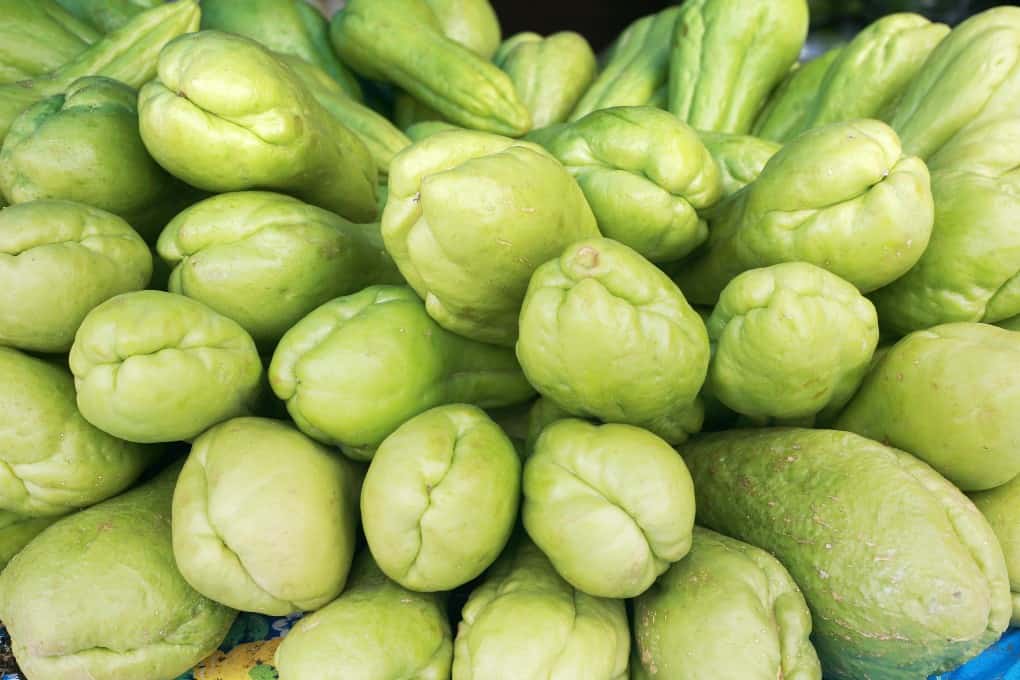
Chayote squash can be found in some grocery stores or specialty fruit and vegetable markets. In the summer, it can sometimes be found at the Farmers’ Market.
Depending on where you live, chayote can be available year-round. If you don’t see it, try asking your produce manager, and remember to check under the name Mirliton as well.
Ripe chayote should be firm to the touch and the skin shouldn’t have any soft spots on it. Store chayote squash in the fridge and use within a few weeks for optimal freshness.
Have you cooked with chayote squash before? What are your favorite things to do with it?
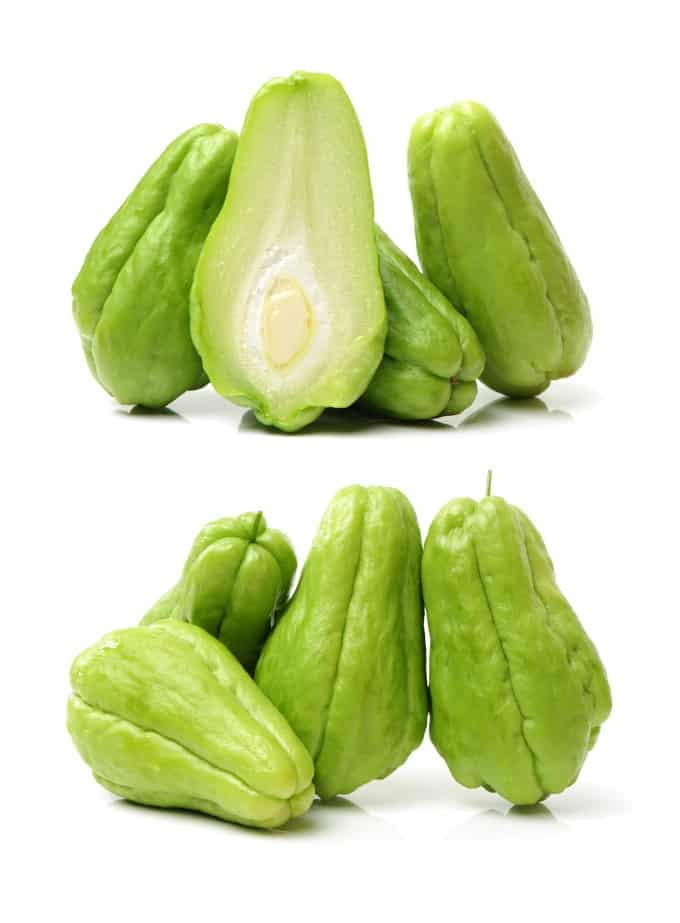
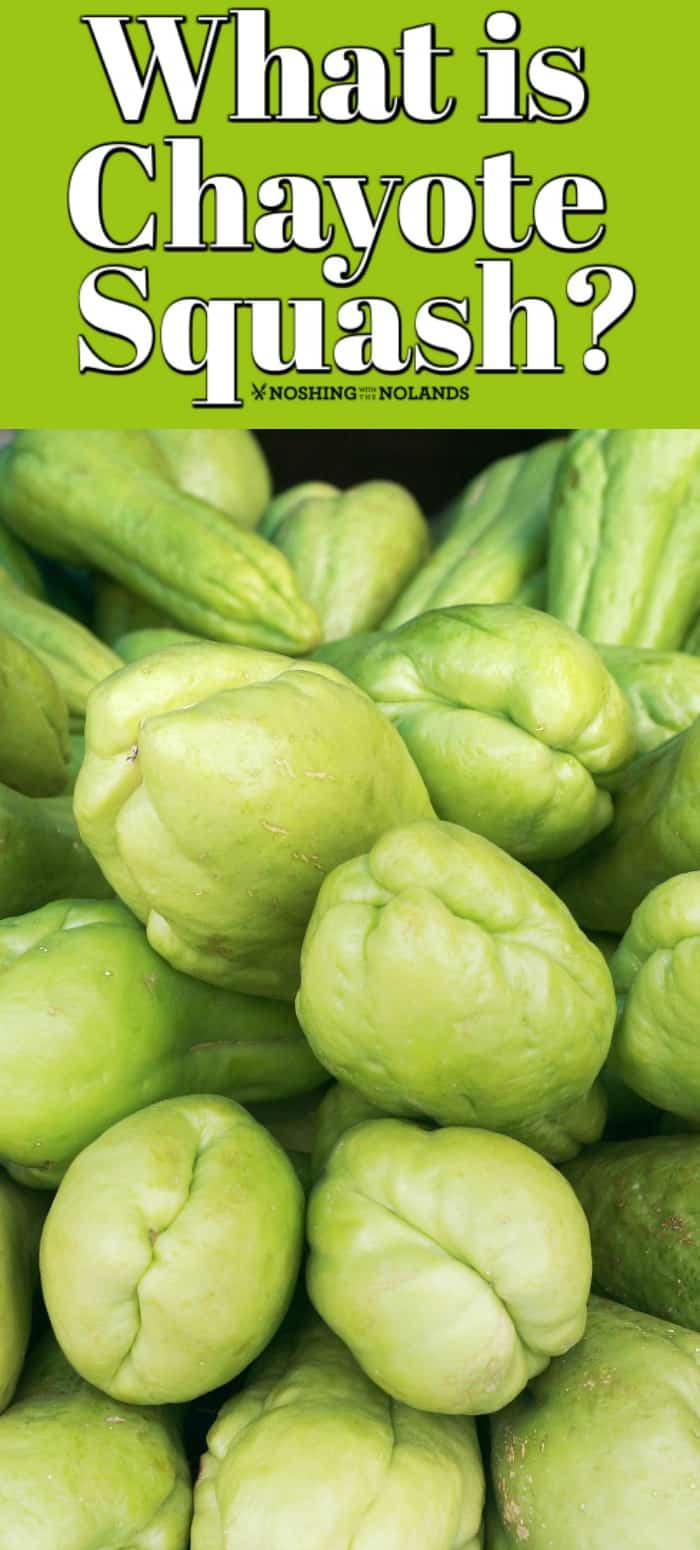

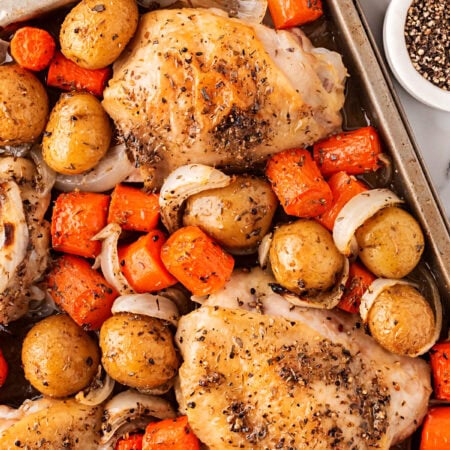


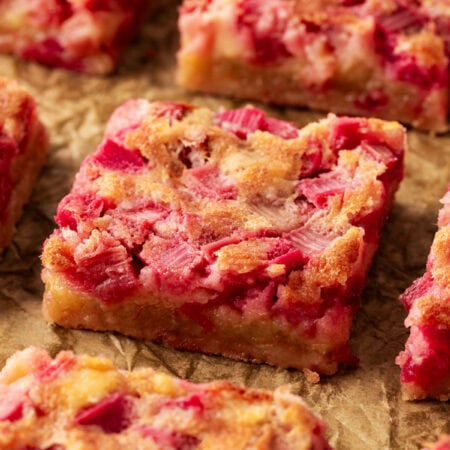

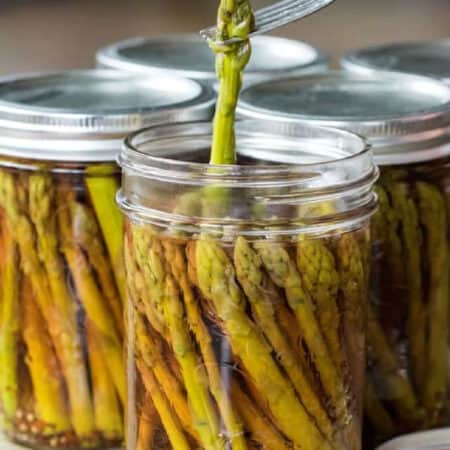

Comments & Reviews
Elenuté says
I saw a stack of these in the store and wondered what they were, who would buy them. So, I bought them and now I’m looking forward to trying it.
Tara Noland says
Enjoy, they can be served in so many ways!!
Nzaramba says
I ate so many chayote in my childhood even until nowadays. In Rwanda, some regions of northern, western band southern province grow them and rarely in eastern province.
They’re edible vegetables and are very delicious, I like them the most!
Tara Noland says
Would love to know how you cooked Nzaramba.
PF says
I use it in Soup together with the other vegetables. Add Chili and Cilantro, and it makes a traditional recipe.
PF says
Is it safe to eat the seed? Some people say it is poisonous. I like the taste of the seed and have eaten it in the past, but no longer.
Tara Noland says
From the little readings I have done the entire vegetable is edible, skin, flesh, and seed.
Nancy says
Uh-oh … I just ate the seed! This is my first experience with this vegetable/fruit. I have a couple of recipes courtesy of Pati Jinich, so am trying it. First is a Chayote and red onion salad, with a vinaigrette dressing. Next I’ll try her chayote, green apple, and jicama salad.
Tara Noland says
I like her recipes, enjoy the chayote!!
Brian says
Love to blanch it, then cut lengthwise. Remove seed and discard. Scoop out some flesh into a mixing bowl. Mix flesh with fresh garlic, onion, salt, cayenne, bread crumbs, chunks of Andouille or kielbasa sausage, & prepared wild rice. Stuff mixture into mirliton halves and bake at 350 degrees. Squeeze lemon when serving…yum!
Tara Noland says
What a great recipe, thank you so much for sharing it here!!
Mike says
I use it in stir fries – I find it coexists well with other vegetables like peppers and potatoes.
It’s a good bachelor vegetable, since it’s durable and keeps well.
S E Silva says
I used to go to my Mom’s neighbor’s house to visit after school, she was a Great Cook! One day I went over and she had so many apple pies, I couldn’t even count them all. She cut me a slice, and of course, as usual I had seconds, it was so good. Then she let me in on her secret. She had used the Chayote squash that was growing out of control in her back yard. Cut up the squash as you would an apple, added all the sugar and spices you would use for apples. Excellent way to use the squash and couldn’t tell the difference from regular apple pie.
Tara Noland says
That is a very cool story, I could see that working too! They are mild-flavored and the texture is like an apple.
Leslie says
That’s what I was wondering! Added it to our Mediterranean salad today. Going to try apple flautus next. Thanks!
Tara Noland says
Enjoy, I am so glad you are trying it.
Stormee Penrod says
That’s a great recipe for me to try.
Christy Mattson says
I cut it up raw and put it in pickle juice then eat it with hummus!
Tara Noland says
That would be awesome too.
Eileen M Loya says
We slice chayote into small cubes, then saute it in garlic, onions, and tomatoes. Add some stock, a little salt and pepper and simmer until soft. Then we add spinach. Great as a side dish!
Tara Noland says
That sounds amazing, we have got to try this recipe, thank you!!
Claudia Krusch says
We have so many Brazilian recipes with it! I’m well familiar with it! Thank you for sharing it!
Ruth I says
It’s called sayote in here. Really cheap and you can make lots of dishes using it.
Rachel says
We have a produce store that always has interesting produce. I do like jicama so I will have to try this.
Catalina says
What an interesting vegetable! I am so curious to taste it! Thanks for sharing it!
Toni says
I haven’t tried it yet but I think it would be great for salads!
Heather says
I’m almost positive that I’ve tried this before. We were always eating all types of different squashes when I was a kid.
Kathy says
I’ve never heard of this type of squash before. I do love squash too. I’m interested to try this out. Looks like it would be good too.
Jeanine says
What in the world. How have I never seen or heard of Chayote Squash before. I am going to have to ask my husband if he has, very neat.
Jaime Prideaux says
Wow, I have never heard of this squash before. The raw squash with lemon or lime or salt sounds interesting. I would like to try that! Thanks for sharing!
Tara Pittman says
I have heard of this squash but never tried it. I am interested in trying it and need to buy one.
Stacie says
I have to give this a try. I’ve never heard of Chayote Squash, but I’m a squash lover, so I’m into it.
C. Dungan says
I boil them after cut in half. Take out meat in middle like stuffing a bell pepper, mix meat with a seafood stuffing, refill top cheese and bake they are awesome. Add good Cajun spices as well. Hope you try this. C.Dungan. South Louisiana .
Tara Noland says
Wow, that sounds amazing, a must-try for sure!!
Renie says
Thx! Just got 3 in a veggie gift box. & had no clue?
Tara Noland says
So happy to help!!
Donna Vanderloo says
I hope you’ve found some to buy. Here in Brazil we call them xuxu and grow the vines in our backyard. The fruits are difficult to spot, so sometimes one is too late to harvest one. This means that a baby plant is already growing out of the fruit, We simply plant them near an old tree and there they start to climb. They like some sunshine but not the whole day.
A neighbor told me that her mother used to make sweet pie with the root-bulb. In very dry seasons the plant can decide to go dormant. And then one can dig up a big tuber, that contains all the sugars,
We only peel the rough parts of the skin. When it is still tender, we leave the skin on and just cut the fruit into pieces. Cook in water until soft. Then throw some spices and some arrowroot powder to bind the rest of the cooking water.